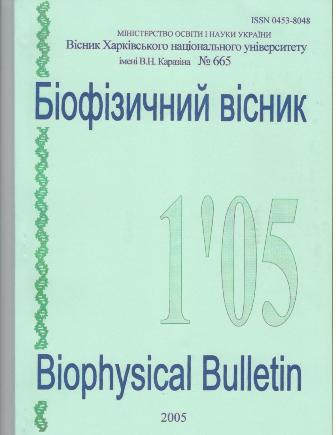Computer simulation of complexation of actinocin derivative and double stranded polyribocytidylic acid
Abstract
Relying on the results of molecular docking and on the known experimental data regarding complexation of actinocin derivative (ActIII) and double stranded polyribocytidylic acid (polyrC), five most probable ActIII - polyrC complexes are obtained. In these complexes target-ligand interactions are minimal and intermolecular hydrogen bonds are formed between donor-acceptor groups of ActIII and polyrC. Cytosine groups and/or oxygen atoms of sugarphosphate backbone of polyrC participate in hydrogen bonding with NH2, C=O, NH-groups of phenoxazone chromophore, and aminoalkyl side chains of ActIII. The influence of solvent-water molecules on the structure of complexes obtained using molecular docking is determined by the Monte Carlo method. The simulation is carried out taking into account 800 water molecules. It is shown, that water molecules can additionally stabilize polynucleotide target-ligand complexes by forming bridges between their donor-acceptor groups. Based on the analysis of simulation and experimental results, one of the ActIII - polyrC complexes is selected as the most probable one.
Downloads
References
2 Больбух Т.В., Близнюк Ю.Н, Круглова Е.Б. и др. // Вісн. ХНУ №637. Біофізичний вісник. 2004. Вип.1(14). С.38-42.
3. Prescott B., Gamache R., Livramdo J., Thomas G.J. // Biopolymers. 1974. V.13, N 10. P. 1821-1845.
4. Yang J.T., Samejima T // Prog.Nid.Acid.Res.Mol.Biol. 1976. V.9. N 2. P.223-300.
5. Leslie A.G.W., Arnott S. // J. Mol.Bi 1978. V.l 19. P.399-414.
6. Langridge R.A., Rich A. // Nature.1963. V.198. N 4882. P.725-728.
7.Cornell W.D., Cieplak P., Bayly C.I. et al. // J. Amer. Chem. Soc. 1995. V.117. P.5179-5192.
8. Jorgensen W.L., Chandrasekhas J., Madura J.D., Impey R.W., Klein M.L. // J. Chem. Phys. 1983. V.79. P.926-935
9. Morris G.M., Goodsell D.S., Halliby R.S. et al. // J. Comput. Chem. 1998. V.19. P. 1639-1651.
1O. Mehler E.L., Solmajer T. //Protein Engineering. 1991. V.4. P.903-910
11. Stouten P.F.W., Frommel C, Nakamura H. et. al. // Mol. Simulation. 1993. V.10. P.97-120
12. Metropolis N., Rosenhluth A.W., Rosenbluth M. N., Teller A.N., Teller E. //J.Chem.Phys. 1953. V.21. P.1087-1092.
13. Danilov V.I., Zheltovsky N.V., Slyusarchuk O.N., Poltev V.I., Alderfer J.L. // J.Biomol.Struct. Dyn. 1997. V. l5. P. 69-80.
14. Maleev V., Semenov M., Kashpur V., Bolbukh T., Shestopalova A., Anishchenko D. // Journal of Mol. Structure.2002. V.605. P.51-61.
15. Maleev V.Ya., Semenov M.A., Kruglova E.B., Bolbukh T.V, Gasan A.I., Bereznyak E.G., Shestopalova A.V. // Journal of Molecular Structure. 2003. V.645. P. 145-158.
16. Teplukhin A.V., Malenkov G.G., Poltev V.I. // J. Biomol. Struct.Dyn. 1998. V.16. N 2. P.289-300
17. Журкин В.Б., Полтев В.И., Флорентьев В.Л. // Мол.биол. 1980. Т.Н. Вып.5. С11116-1130.
18. Poltev V. L, Groklina T.I., Malenkov G.G. // J.Biomol. StructDyn. 1984. V.2. N 3. P.413-429.
19. Qu X., Chaires B. Hydration changes for DNA intercalation reactions. //J.Amer.Chem.Soc. 2001. V.123. P. 1-7.
20. Breusegem S.Y., Sadat-Ebrahimi S.E., Douglas K.T., Bichenkova E.V., Clegg R.M., Loontiens F.G. // J.Med.Chem. 2001.V.44. P. 2503-2506.
Authors who publish with this journal agree to the following terms:
- Authors retain copyright and grant the journal right of first publication with the work simultaneously licensed under a Creative Commons Attribution License that allows others to share the work with an acknowledgement of the work's authorship and initial publication in this journal.
- Authors are able to enter into separate, additional contractual arrangements for the non-exclusive distribution of the journal's published version of the work (e.g., post it to an institutional repository or publish it in a book), with an acknowledgement of its initial publication in this journal.
- Authors are permitted and encouraged to post their work online (e.g., in institutional repositories or on their website) prior to and during the submission process, as it can lead to productive exchanges, as well as earlier and greater citation of published work (See The Effect of Open Access).





